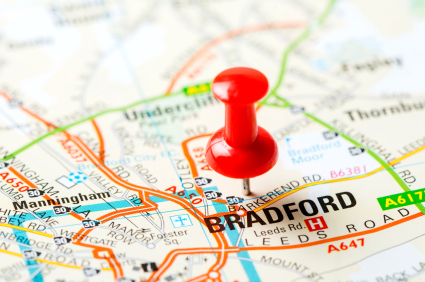 The city of Bradford has been firmly positioned in the international map for a couple of centuries. Bradford was among the first British cities to be transformed by the industrialisation process, and became known around the world as an international wool capital. Much has changed in Bradford since those days, as textile manufacturing has largely been replaced by a thriving and diverse economy that has attracted people from many parts of the UK and the world. In this article of our series “The Changing Face of Britain’s Cities”, we take a detailed look at Bradford’s population and its economy.
The city of Bradford has been firmly positioned in the international map for a couple of centuries. Bradford was among the first British cities to be transformed by the industrialisation process, and became known around the world as an international wool capital. Much has changed in Bradford since those days, as textile manufacturing has largely been replaced by a thriving and diverse economy that has attracted people from many parts of the UK and the world. In this article of our series “The Changing Face of Britain’s Cities”, we take a detailed look at Bradford’s population and its economy.
An overview of recent demographic trends in Bradford
The main characteristic of Bradford’s demographic trends has been a steady increase in population numbers, especially from the early 1800s onwards. Historic records show that in 1801, Bradford’s population barely reached the 13,000 mark. Just fifty years later, the city’s population had grown to 104,000. Another fifty years of continued growth brought Bradford’s population to 280,000 in 1901. These figures show that Bradford grew at a faster pace than some of the largest English cities, such as Manchester, Liverpool, or Birmingham.
Bradford has also followed a distinctive trend that has set it apart from other cities in Yorkshire. Whereas in the last decade the general trend here has been marked by very slow population growth levels (around 6 per cent), Bradford’s population has grown by more than 11 per cent during the same period. According to the latest census statistics, Bradford’s population currently exceeds 522,000 people, which makes of the city the fourth most populous metropolitan area in England.
Bradford’s unusual demographic makeup is evident in yet another aspect. There is a rapidly increasing percentage of population aged 5 years old and under. Currently, 7.9 per cent of Bradford’s residents are within this age group, whereas the English average is barely 6 per cent. Approximately 22 per cent of the population is aged 14 or under.
Another key demographic trend in Bradford has to do with its increasingly diverse ethnic population. Currently, white British residents account for 76.1 per cent of the total population. Bradford has a high percentage of residents of Asian origin, most notably Pakistani (20.4 per cent of all ethnic minorities) and Bangladeshi.
The economy in Bradford
Although Bradford’s economy thrived during the 19th century thanks to the textile trade, things changed for the city after de-industrialisation, when a period of severe decline affected the local economy. This was most evident in the city’s unemployment levels, which were among the highest in the country. As of 2011, in some parts of the city unemployment rates exceeded the 25 per cent mark. However, in economic terms Bradford is a city of contrasts, as research has shown that some local wards fall within the 10 per cent less deprived areas in the United Kingdom.
The local authority has put a lot of work into countering the deprivation indexes of the city. Over the past decade, the key economic strategy has been to support companies in areas like finance and retail. So far, this strategy has been successful, as it is estimated that Bradford’s economy is now worth £8.3 billion. In an effort to attract companies and investment to the city, several regeneration projects have been launched, such as the Bradford Street Economic Regeneration Scheme, the Canal Road Corridor, or the city council’s Growth Zone Initiative.
According to recent statistics, approximately 12 per cent of all business initiatives in Bradford are recent start-ups, a figure that is an encouraging sign onf economic growth and potential.
Recent industry trends in Bradford
Finance and business services have recently become two of the most important industrial sectors in Bradford. Some renowned employers, such as Provident Financial, Santander-Abbey, or the Yorkshire Building Society, are headquartered in the city. Retail is among the highest value industries in Bradford too, as approximately 14 per cent of the city’s 15,000 businesses are involved in this activity.
The number of firms involved in professional, scientific, and technical services is also on the rise, and currently they account for 11 per cent of all businesses in Bradford. Next are construction (9 per cent), food and drink production (8.4 per cent), and health care services (8 per cent).
Textile manufacturing has lost its crucial importance in Bradford, but the sector is still present in the city. Some key employers in this industry are Bulmer & Lumb and the British Wool Marketing Board. The manufacturing sector has followed a similar pattern, adapting itself to the global economy. Nowadays, Bradford is home to a number of large companies in food, electronics, and chemical manufacturing. Important employers in these sectors include BASF, Pace Micro, Seabrook, CIBA Chemicals, Bailey Offiste, and Denso Marston.

